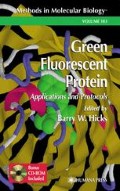Abstract
The green fluorescent protein (GFP) from the jellyfish Aequorea victoria has become one of the most important markers for studying gene expression and protein targeting in intact cells and organisms (1–3). GFP represents the first genetically encoded reporter molecule that is detectable in the absence of an enzymatic substrate or cofactor, in a variety of cell types.
Access this chapter
Tax calculation will be finalised at checkout
Purchases are for personal use only
References
Pollok, B. A. and Heim, R. (1999) Using GFP in FRET-based applications. Trends Cell Biol. 9, 57–60.
Goodwin, P.C. (1999) GFP biofluorescence: imaging gene expression and protein dynamics in living cells. Design considerations for a fluorescence imaging laboratory. Meth. Cell Biol. 58, 343–367.
Ikawa, M., Yamada, S., Nakanishi, T., and Okabe, M. (1999) Green fluorescent protein (GFP) as a vital marker in mammals. Curr. Top. Dev. Biol. 44, 1–20.
Thornton, J. M. and Sibanda, B. L. (1983) Amino and carboxy-terminal regions in globular proteins. J. Mol. Biol. 167, 443–160.
Heinemann, U. and Hahn, M. (1995) Circular permutation of polypeptide chains: implications for protein folding and stability. Prog. Biophys. Mol. Biol. 64, 121–143.
Rojas, A., Garcia-Vallve, S., Palau, J., and Romeu, A. (1999) Circular permutations in proteins. Biologia 54, 255–277.
Goldenberg, D. P. and Creighton, T. E. (1983) Circular and circularly permuted forms of bovine pancreativ trypsin inhibitor. J. Mol. Biol. 165, 407–113.
Luger, K., Hommel, U., Herold, M., Hofsteenge, J., and Kirschner, K. (1989) Correct folding of circularly permuted variants of a βα barrel enzyme in vivo. Science 243, 206–210.
Viguera, A. R., Blanco, F. J., and Serrano, L. (1995) The order of secondary structure elements does not determine the structure of a protein but does affect its folding kinetics. J. Mol. Biol. 247, 670–681.
Zhang, T., Bertelsen, E., Benvegnu, D., and Alber, T. (1993) Circular permutation of T4 lysozyme. Biochemistry 32, 12,311–12,318.
Wieligmann, K., Norledge, B., Jaenicke, R., and Mayr, E.-M. (1998) Eye lens βB2-crystallin: circular permutation does not influence the oligomerization state but enhances the conformational stability. J. Mol. Biol. 280, 721–729.
Yang, Y. R. and Schachman, H. K. (1993) Aspartate transcarbamoylase containing circularly permuted catalytic polypeptide chains. Proc. Natl. Acad. Sci. USA 90, 11,980–11,984.
Graf, R. and Schachman, H. K. (1996) Random circular permutation of genes and expressed polypeptide chains: application of the method to the catalytic chains of aspartate transcarbamoylase. Proc. Natl Acad. Sci. USA 93, 11,591–11,596.
Hennecke, J., Sebbel, P., and Glockshuber, R. (1999) Random circular permutation of DsbA reveals segments that are essential for protein folding and stability. J. Mol. Biol. 286, 1197–1215.
Iwakura, M., Nakamura, T., Yamane, C. and Maki, K. (2000) Systematic circular permutation of an entire protein reveals essential folding elements. Nat. Struct. Biol. 7, 580–585.
Cubitt, A. B., Heim, R., Adams, S. R., Boyd, A. E., Gross, L. A., and Tsein, R. Y. (1995) Understanding, improving and using green fluorescent proteins. Trends Biochem. Sci. 30, 448–55.
Topell, S., Hennecke, J., and Glockshuber, R. (1999) Circularly permuted variants of the green fluorescent protein. FEBS Lett. 457, 283–289.
Baird, G. S., Zacharias, D. A., and Tsien, R. Y. (1999) Circular permutations and receptor insertion within green fluorescent proteins. Proc. Natl. Acad. Sci. USA 96, 11,241–11,246.
Chattoraj, M., King, B. A., Bublitz, G. U., and Boxer, S. G. (1996) Ultra-fast excited state dynamics in green fluorescent protein: multiple states and proton transfer. Proc. Natl. Acad. Sci. USA 93, 8362–8367.
Cormack, B. P., Valdivia, R. H., and Falkow, S. (1996) FACS-optimizedmutants of the green fluorescent protein (GFP). Gene 173, 33–38.
Yang, T.-T., Cheng, L., and Kain, S. R. (1996) Optimized codon usage and chromophore mutations provide enhanced sensitivity with the green fluorescent protein. Nucl. Acids Res. 24, 4592–593.
Martinez, J. C., Viguera, A. R., Berisio, R., et al. (1999) Thermodynamic analysis of α-spectrin SH3 and two of its circular permutants with different loop lengths: discerning the reasons for rapid folfing in proteins. Biochemistry 38, 549–559.
Llinas, M. and Marquese, S. (1998) Subdomain interactions as a determinant in the folding and stability of T4 lysozyme. Protein Sci. 7, 96–104.
Heim, R. and Tsien, R. Y. (1996) Engineering green fluorescent protein for improved brightness, longer wavelengths and fluorescence resonance energy transfer. Curr. Biol. 6, 178–182.
Miyawaki, A., Lopis, J., Heim, R., McCaffery, J. M., Adams, J. A., Ikura, M., and Tsien, R. Y. (1997) Fluorescent indicators for Ca2+based on green fluorescent proteins and calmodulin. Nature 388, 882–887.
Ward, W. W. (1981) Properties of the coelenterate green-fluorescent proteins, in Bioluminescence and Chemiluminescence: Basic Chemistry and Analytical Applications. (De Luca, M. and McElroy, D. W., eds.), Academic, New York, pp. 235–242.
Patterson, G. H., Knobel, S. M., Sharif, W. D., Kain, S. R. and Piston, D. W. (1997) Use of the green fluorescent protein and ist mutants in quantitative fluorescence microscopy. Biophys. J. 73, 2782–2790.
Lund, A. H., Duch, M., and Pedersen, F. S. (1996) Increased cloning efficiency by temperature-cycle ligation. Nucl. Acids Res. 24, 800–801.
Yang, F., Moss, L. G., and Phillips, G. N., Jr. (1996) The molecular structure of green fluorescent protein. Nat. Biotech. 14, 1246–1251.
Koradi, R., Billeter, M., and Wüthrich, K. (1996) (MOLMOL: a program for display and analysis of macromolecular structures. J. Mol. Graph. 14, 51–55.
Author information
Authors and Affiliations
Editor information
Editors and Affiliations
Rights and permissions
Copyright information
© 2002 Humana Press Inc.
About this protocol
Cite this protocol
Topell, S., Glockshuber, R. (2002). Circular Permutation of the Green Fluorescent Protein. In: Hicks, B.W. (eds) Green Fluorescent Protein. Methods in Molecular Biology, vol 183. Humana Press. https://doi.org/10.1385/1-59259-280-5:031
Download citation
DOI: https://doi.org/10.1385/1-59259-280-5:031
Publisher Name: Humana Press
Print ISBN: 978-0-89603-905-6
Online ISBN: 978-1-59259-280-7
eBook Packages: Springer Protocols

